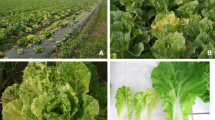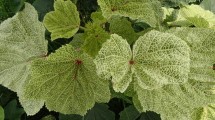Abstract
Yellow vein mosaic, a disease causing serious reductions in fibre yield of mesta (Hibiscus cannabinus and Hibiscus sabdariffa) and associated with a begomovirus, was effectively transmitted by cleft grafting and whitefly (Bemisia tabaci), but not through seed or by mechanical means. Association of the begomovirus with infected experimental host plants was determined by Southern hybridisation using a DNA A targeting probe and PCR amplification primed with specific primers. The minimum whitefly acquisition access period was 12 h and the minimum inoculation access period was 4 h. The minimum incubation period was 9 days. The whitefly transmission efficiency was 85% for H. sabdariffa and 78% for H. cannabinus. The transmissibility through cleft grafting was 80% to H. sabdariffa and 60% to H. cannabinus. The same isolate produced leaf crumpling symptoms in Vigna umbellata and Vigna unguiculata ssp. unguiculata (cowpea). The virus infection causing yellow vein mosaic symptoms on mesta was confirmed by back inoculation and molecular diagnostics. The disease incidence in fields was found to be 92.5% for H. sabdariffa and 89.5% for H. cannabinus, while under experimental conditions the incidence was of 63.7% and 37.2%, respectively.
Similar content being viewed by others
References
Boulton M (2003) Geminiviruses: major threats to world agriculture. The Annals of Applied Biology 142, 143. doi: 10.1111/j.1744-7348.2003.tb00239.x
Briddon RW, Markham PG (1994) Universal primers for the PCR amplification of dicot-infecting geminiviruses. Molecular Biotechnology 1, 202–205.
Briddon RW, Bull SE, Amin I, Idris AM, Mansoor S et al. (2003) Diversity of DNA β, a satellite molecule associated with some monopartite Begomoviruses. Virology 312, 106–121. doi: 10.1016/S0042-6822(03)00200-9
Brunt AA, Crabtree K, Dallwitz MJ, Gibbs AJ, Watson L, Zurcher EJ (Eds) (1996) Plant viruses online: description and lists from the VIDE Database. Available at http://image.fs.uidaho.edu/vide/refs.htm [Verified 4 June 2008]
Chatterjee A, Ghosh SK (2007a) A new monopartite begomovirus isolated from Hibiscus cannabinus L. in India. Archives of Virology 152, 2113–2118. doi: 10.1007/s00705-007-1029-7
Chatterjee A, Ghosh SK (2007b) Association of a satellite DNA β molecule with mesta yellow vein mosaic disease. Virus Genes 35, 835–844. doi: 10.1007/s11262-007-0160-6
Chatterjee A, Roy A, Padmalatha KV, Malathi VG, Ghosh SK (2005a) Yellow vein mosaic disease of Kenaf (Hibiscus cannabinus) and Roselle (H. sabdariffa) — a new disease in India caused by a Begomovirus. Indian Journal of Virology 16, 55–56.
Chatterjee A, Roy A, Padmalatha KV, Malathi VG, Ghosh SK (2005b) Occurrence of a Begomovirus with yellow vein mosaic disease of mesta (Hibiscus cannabinus and Hibiscus sabdariffa). Australasian Plant Pathology 34, 609–610. doi: 10.1071/AP05062
Chatterjee A, Roy A, Ghosh SK (2006) Yellow vein mosaic disease of kenaf. In ‘Characterization, diagnosis and management of plant viruses. Vol. 1: Industrial crops’. (Eds GP Roa, SM Paul Khurana, SL Lenardon) pp. 497–505. (Studium Press: Houston, TX)
Chatterjee A, Sinha SK, Roy A, Sengupta DN, Ghosh SK (2007) Development of diagnostics for DNA A and DNA β of a begomovirus associated with mesta yellow vein mosaic disease and detection of geminiviruses in mesta (Hibiscus cannabinus L. and H. sabdariffa L.) and some other plant species. Journal of Phytopathology 155, 683–689. doi: 10.1111/j.1439-0434.2007.01296.x
Deng D, Mc.Grath PF, Robinson DJ, Harrison BD (1994) Detection and differentiation of whitefly-transmitted geminiviruses in plants and vector insects by the polymerase chain reaction with degenerate primers. The Annals of Applied Biology 125, 327–336. doi: 10.1111/j.1744-7348.1994.tb04973.x
Dhanju K, Dhillon GS, Singh M (1993) Reaction of French bean varieties (Bush type) against bean yellow mosaic virus. Indian Journal of Virology 9, 143–146.
Dhingra KL, Chenulu VV, Goswami K (1983) Evaluation of soybean varieties and germplasm lines for resistance to yellow mosaic. Seeds and Farms 10, 29–33.
Duke JA (1986) ‘Isthmian ethnobotanical dictionary.’ (Scientific Publisher: Jodhpur, India)
Gerling D, Horawitz AR, Paumgartney (1986) Autecology of Bemisia tabaci. Agriculture Ecosystems & Environment 17, 5–19. doi: 10.1016/0167-8809(86)90022-8
Gilbertson RL, Hidayat SH, Martinez RT, Leong SA, Faria JC, Morales F, Maxwell DP (1991) Differentiation of bean infecting geminiviruses by nucleic acid hybridization probes and aspect of bean golden mosaic in brazil. Plant Disease 75, 336–342.
Harrison BD (1985) Advances in geminivirus research. Annual Review of Phytopathology 23, 55–82. doi: 10.1146/annurev.py.23.090185.000415
Hayati JJ, Varma JP (1984) Host and environment response to whitefly transmission of tomato. Indian Phytopathology 37, 223–227.
Horn NM, Reddy SV, Reddy DVR (1995) Assessment of yield losses caused by chickpea chlorotic dwarf geminivius in chickpea (Cicer arietinum) in India. European Journal of Plant Pathology 101, 221–224. doi: 10.1007/BF01874768
Idris AM (1990) Cotton leaf curl disease in Sudan. Mededelingen Faculteit Landbouwwetenschappen Rijksuniversiteit Gent 55, 1990–1992.
Jones DR, Behncken GM (1980) Hibiscus chiorotic ringspot, a widespread virus disease in the ornamental Hibiscus rosa-sinensis. Australasian Plant Pathology 9, 4–5. doi: 10.1071/APP9800004
Jose J, Usha R (2000) Extraction of geminiviral DNA from a highly mucilaginous plant (Abelmoschus esculentus). Plant Molecular Biology Reporter 18, 349–355. doi: 10.1007/BF02825062
Khan JA (2000) Detection of tomato leaf curl geminivirus in its vector Bemisia tabaci. Indian Journal of Experimental Biology 38, 512–515.
Lazarowitz SG (1992) Geminiviruses: Genome structure and gene function. Critical Reviews in Plant Sciences 11, 327–349. doi: 10.1080/713608038
Mansoor S, Briddon RW, Zafar Y, Stanley J (2003) Geminivirus disease complexes: an emerging threat. Trends in Plant Science 8, 128–134. doi: 10.1016/S1360-1385(03)00007-4
Mehta P, Jeffrey AW, Nakhla MK, Douglas PM (1994) Transmission of tomato yellow leaf curl geminivirus by Bemisia tabaci (Homoptera: Aleyrodidae). Journal of Economic Entomology 87, 1291–1297.
Narula AM, Monga D, Chauhan MS, Raj S (1999) Cotton leaf curl disease in India — the challenge ahead. Journal of Cotton Research and Development 13, 129–138.
Pal DC, Jain SK (1998) ‘Tribal medicine.’ (Naya Prakash: Calcutta, India)
Pandit NC, Pathak S (2000) ‘Management of insect pests in mesta.’ (Central Research Institute for Jute and Allied Fibres, ICAR: Barrackpore, India)
Saikia AK (1985) Studies on epidemiology and control of tomato leaf curl virus. PhD Thesis, University of Agricultural Science, Bangalore, India.
Saikia AK, Muniyappa V (1989) Ultrastructural changes in phloem cells of leaf curl affected tomato from India. Journal of Phytopathology 124, 1–6.
Singh JAS, Sahi Mann HS, Kapur SP (1994) Studies on whitefly Bemisia tabaci (Genn) transmitted cotton leaf curl virus disease in Punjab. Journal of Insect Science 7, 194–198.
Author information
Authors and Affiliations
Corresponding author
Rights and permissions
About this article
Cite this article
Chatterjee, A., Roy, A. & Ghosh, S.K. Acquisition, transmission and host range of a begomovirus associated with yellow vein mosaic disease of mesta (Hibiscus cannabinus and Hibiscus sabdariffa). Australasian Plant Pathology 37, 511–519 (2008). https://doi.org/10.1071/AP08049
Received:
Accepted:
Issue Date:
DOI: https://doi.org/10.1071/AP08049




